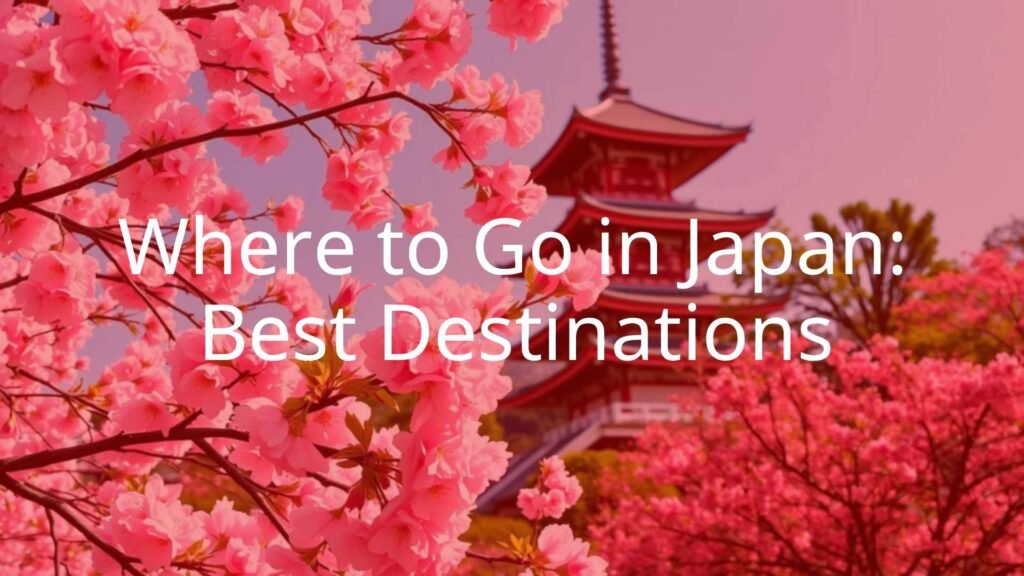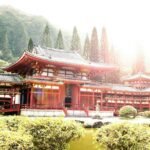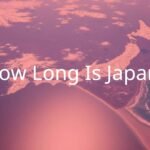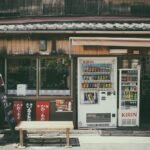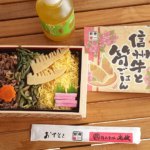Japan, often known as the Land of the Rising Sun, is a group of islands where old customs meet modern city life. With a history going back 30,000 years, Japan has a rich culture, beautiful scenery, and busy cities. From the fleeting look of cherry blossoms to relaxing in a hot spring, and from busy city streets to calm beaches, Japan truly has a place for every visitor.
Instead of asking if you should visit Japan, the real question is where to start your journey in this incredible country. With so many interesting areas and famous sites, picking the best spots can seem overwhelming. This guide will help you narrow down your choices by giving you a clear look at Japan’s top destinations, so your trip is both fun and memorable.

Where to Go in Japan: Top Spots for All Travelers
Japan has a variety of things to do, making it easy for everyone to find something enjoyable. Whether you love exploring historical buildings, want to try new food, like outdoor walks, or enjoy the nightlife of the city, Japan has the right place for you. The mix of old and new in the country means that on one trip, you might find yourself quietly walking in a garden one moment and enjoying city life the next.
One of the best parts of Japan is its ability to surprise visitors. Every area, city, and village has its own personality, giving you a different look at Japanese culture. Think about what interests you the most as you plan, and get ready to discover everything this amazing country has to offer.
How to Pick the Right Japanese Destination
Choosing where to go in Japan can be tough, simply because there are so many great options. It’s like being in a candy store with too many choices. Instead of candy, you’ll find famous historical sites, lively markets, and peaceful parks. To get the most from your trip, match your destinations to what you enjoy most.
Decide if you want the excitement of a big city, the peace of a small village, the challenge of mountain hikes, or the calm of a beach. Japan’s high-speed trains, especially the Shinkansen, make it easy to reach many places on the same trip. Still, planning your route before you go will help you spend more time sightseeing and less time traveling between places.
Things to Think About for Your Japan Trip
- Your Main Interests: Pick places that match what you like – for culture and temples, visit Kyoto or Nara; for tech and nightlife, head to Tokyo or Osaka; for outdoor activities, check out Hokkaido or the Japanese Alps.
- How Fast You Travel: Figure out if you want to spend longer in each place or see as many places as you can. The trains are fast, but travel takes time.
- Your Budget: Japan can be pricey in big cities, but smaller towns usually have cheaper places to stay and eat.
- Your Group: Solo travelers, families, and couples might all want different things, so plan with your group in mind.
Best Time to Visit Each Region
| Season | Months | Highlights |
|---|---|---|
| Spring | March-May | Cherry blossoms bloom, especially in Tokyo and Kyoto. High demand for hotels and trains. |
| Summer | June-August | Green landscapes and hiking in Hokkaido and the Alps; great for Okinawa beaches, but watch for heat in cities. |
| Autumn | September-November | Colorful leaves in Nikko, Tohoku, and the Alps. Comfortable weather for walking and sightseeing. |
| Winter | December-February | Skiing in Hokkaido, snow festivals, and relaxing in onsen. Good for seeing light displays in cities. |

Should You Visit Both Tokyo and Kyoto?
If it’s your first time in Japan, seeing both Tokyo and Kyoto is highly suggested. These two cities are quite different but together show you both sides of Japanese life. Tokyo is a huge, modern city full of new trends, amazing food, and lively areas like Ginza and Akihabara. Kyoto is full of old temples and shrines, beautiful gardens, and traditional geisha areas like Gion. Spending three or four days in Kyoto gives you enough time to explore its history. It’s easy to travel between the two cities with the high-speed train.
Top Destinations by Area
| Region | Main Features | Highlights |
|---|---|---|
| Honshu | Main island, biggest cities, culture, nature | Tokyo, Kyoto, Osaka, Hiroshima |
| Hokkaido | Nature, outdoor sports, cold winters | Sapporo, ski resorts, flower fields |
| Shikoku & Kyushu | Rural areas, pilgrimages, volcanoes, beaches | 88 Temple Pilgrimage, Fukuoka, Yakushima |
| Okinawa & Southern Islands | Beaches, warm weather, unique culture | Naha, Kerama Islands, diving spots |

Honshu: Central Cities and Sights
Honshu is Japan’s main island, home to big cities like Tokyo, Kyoto, and Osaka. You’ll find lots of historic sites, beautiful parks, shopping areas, and food spots. Getting around is easy with many train lines. Highlights include Hiroshima, Takayama’s old town, and Kanazawa’s gardens.
Hokkaido: Great for Nature Lovers
Up north, Hokkaido is perfect if you love mountains, parks, and snow. In winter, Sapporo’s Snow Festival is famous, and ski resorts like Niseko welcome visitors from all over the world. Summer brings bright flower fields and great hiking.
Shikoku and Kyushu: Quiet Countryside and Island Feel
Shikoku is best known for its temple pilgrimage and peaceful landscapes. Kyushu has volcanoes, historic areas, and tasty food. Don’t miss hot springs in Beppu and the ancient forests of Yakushima. Both islands offer a slower lifestyle and local culture.
Okinawa & Southwest Islands: Japan’s Tropical Side
Okinawa and its many islands have warm weather, sandy beaches, and clear blue water. Great for diving, relaxing, and learning about the Ryūkyū Kingdom’s history. The main island has interesting museums and aquarium, while smaller islands are good for snorkeling and whale watching.
Main Cities and Cultural Spots
- Tokyo: Huge city with everything from robot cafés to ancient shrines. Best for food, shopping, and nightlife.
- Kyoto: Old temples, traditional gardens, geisha districts, a must for learning about classic Japan.
- Osaka: Famous for street food and lively nightlife. Try okonomiyaki and takoyaki in Dotonbori.
- Hiroshima: Peace Memorial Park and Museum, as well as quiet gardens and day trips to Miyajima.
- Fukuoka: Gateway to Kyushu, best known for Hakata ramen and beaches.
- Nagoya: Mix of modern industry and history, famous for Nagoya Castle and Tokugawa Art Museum.
- Sapporo: Snow festivals, Sapporo beer, and access to ski resorts.
- Yokohama: Near Tokyo, with a busy port, Chinatown, and waterfront sights.
Japan’s Best Nature and Scenic Spots
- Mount Fuji & Fuji Five Lakes: Most famous mountain, hiking, great views, and lakes nearby for boating and onsen.
- Hakone: Hot springs, art museums, lake cruises, and views of Mount Fuji.
- Nikko: Beautiful shrines, waterfalls, and a national park especially colorful in fall.
- Izu Peninsula: Rocky coast, beaches, hiking, and lots of hot springs.
- Chubu Sangaku National Park (Kamikochi): High mountains and walking trails, perfect for hiking lovers.
- Yakushima: Old cedar forests, waterfalls, and unique animals like deer and monkeys.
- Lake Biwa: Big freshwater lake, bike trails, boat rides, and peaceful views close to Kyoto.

Traditional Towns and Historical Villages
- Nara: Old capital, big temples, and lots of friendly deer in the parks.
- Kanazawa: Known for well-kept samurai and geisha districts, plus beautiful gardens.
- Takayama: Small mountain city with a historic center and popular spring and autumn festivals.
- Shirakawa-go and Gokayama: Villages famous for steep thatched roof houses, like out of a fairy tale.
- Kurashiki: Old canal city with nice walks, boat rides, and local museums.
- Kamakura: Temple city near the sea, best known for the giant Buddha statue and beach access.
Islands and Coastal Destinations
- Okinawa: Clear waters, white beaches, and a culture all its own. Good for diving, festivals, and learning history.
- Naoshima: Called “Art Island,” filled with museums and modern art sculptures; best during art festivals.
- Miyajima: Famous floating torii gate, wild deer, and peaceful walks-great for photos.
- Sadogashima: Rural island with old mines, open-air festivals, and beautiful hiking routes.
- Shikoku: Peaceful, lots of temples, cycling islands-to-island across bridges, great for those seeking slow travel.
- Nagasaki: Port city with international history, unique blend of western and Japanese sites.
Hidden and Less-Visited Places in Japan
- Kumano Kodo (Kii Peninsula Walks): Ancient pilgrimage routes where you can hike through mountains and stay in small villages.
- Tohoku: Less crowded area with natural beauty and old traditions, hot springs, and colorful leaves in autumn.
- Onomichi & Shimanami Kaido: Port town with a famous cycling path over bridges to smaller islands.
- Mt. Koya (Koyasan): Sacred mountain area, lots of temples, and chance to stay overnight like a monk.
- Gujo Hachiman: River town with a big summer dance festival and clear water canals.
- Furano and Niseko: In Hokkaido, Niseko is great for winter sports and Furano for summer flower fields.
Japan’s Top Destinations: Simple Takeaways
Japan is a country where the old and new come together in unique ways. You’ll see the past in Kyoto’s shrines, the future in Tokyo’s city lights, and nature’s wild beauty from Hokkaido’s snows to Okinawa’s beaches. What makes Japan stand out is not just the famous places or food, but the care people put into everything, big or small. From finding your way on the subway to trying a meal at a local restaurant, you’ll notice the friendliness and attention to detail. Japan is more than just a place to visit-it is a full experience that will stick with you. You’ll leave wanting to see more. So, pack light, keep an open mind, and get ready to enjoy everything Japan shares with its guests.
- What Is a Maiko? - July 13, 2025
- What Does Domo Arigato Mean? - July 12, 2025
- What Does Naruto Mean? - July 12, 2025

